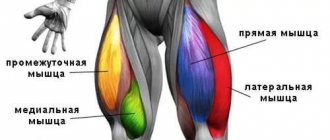Good flexibility is the key to a healthy and beautiful body. Stretching to the splits reduces the risk of injury, helps you lose weight and improves women's health. Besides – it’s just beautiful! If you dream of doing the splits at home, then see our selection of the best stretching exercises for longitudinal and transverse splits for different levels of training.
How to do the splits for beginners - 5 simple stretches for everyone
Before each workout, you must warm up. To do this, you can do a light jog or yoga exercises for 5-10 minutes. This is necessary to increase the intensity of blood circulation throughout the body. When body temperature is increased, mobility improves, as a result of which stretching becomes easier and more effective, and performing splits exercises without warming up is not only less effective, but also dangerous, as the risk of injury increases.
Runner's Knee Lunge
The runner's lunge is typically performed as a person prepares to perform a side split.
- Basic stance with feet together
- Step your right foot forward while simultaneously extending your left leg back
- Lower your knee toward the floor until your front knee is vertical over your foot. In this case, a stretch should be felt in the femoral flexor (thigh muscle)
- Think about driving the left hip flexor into the floor for increased effect.
- Hold for 20-30 seconds. Repeat 2-3 times on each side.
Bent Over Hamstring Stretch
To stretch your hamstrings, you need to extend your leg in front of you. This exercise will also help you get into a split position.
- From a runner's knee lunge position, extend your front leg and squat down onto your heel.
- Keep your back straight while stretching forward
- Stretch your torso toward your thigh, not toward your front toes.
- Hold for 20-30 seconds. Repeat 2-3 times on each side.
Deep lunge to the side
The side lunge exercise is essential for strengthening your quadriceps, hips, and adductor muscles, specifically the adductor longus, adductor brevis, and adductor magnus.
This exercise will strengthen the muscles of the inner thigh, which will improve control when moving into the split position.
- Basic feet together
- Step to the right and lunge to the side with your knee vertical over your foot.
- Place your left hand on the floor. With your right hand, intensively move your right knee outward. There should be a stretching sensation in the inner left thigh and right hip flexor.
- Hold for 20-30 seconds. Repeat 2-3 times on each side
Pigeon pose
I would recommend doing this stretch every day. This pose stretches the hip flexors, gluteus minimus and maximus, as well as the piriformis and psoas muscles. This is to improve control so that your hips are level.
- Get on all fours
- Extend your right knee so that your ankle is behind your left wrist. The front leg should be bent 45-90 degrees, depending on the shape of the skeleton and level of flexibility.
- Stretch your left leg back and place the top of your foot on the floor
- The right ankle should not be under the left thigh. To do this, move your left leg back even more
- Both hips should be at the same level
- Place your hands on the floor and lower yourself to your elbows or lower
- Stay in this position for 20-30 seconds. Repeat 2-3 times on each side
Leg Supported Pigeon Pose
There are many variations of pigeon pose for different levels of flexibility. This option is a little more complicated. You will feel a stronger stretch in your hip flexors.
- Assume pigeon pose with your right foot in front. Bend your leg behind you so that your toes point toward the ceiling.
- Reach back to grab your left leg with your left hand
- Pull your left leg towards your torso
- Press your left thigh to the floor if you feel a rise
- Stay in this position for 20-30 seconds. Repeat 2-3 times on each side
If you don't reach the floor with any of these exercises, use yoga blocks to correct your position.
Erin Motz, a yoga instructor with more than thirteen years of experience, says, “You should strive for proper form, and depth will come naturally with time, so don't try to do the exercises to the limit. The hips should hit at the same level. Make sure the thigh bones are positioned one behind the other."
Analyzing my mistakes, I can say that correct technique is the key to development, even if it means using blocks.
Transverse and longitudinal
There are two types of twine - longitudinal and transverse. In the first case, one leg is in front of the body and the other is behind, the legs are positioned perpendicular or at an acute angle to the body. It can be left- or right-sided, depending on the leg in front.
© F8studio — stock.adobe.com
With the transverse, the legs are spread apart to an angle of 180 degrees or more. In this case, they are located on the sides, as opposed to longitudinally.
© Nadezhda — stock.adobe.com
Scientists say that cross splits are easier for men than for women. This is due to the structure of the female body; the tone of the adductor muscles prevents quick and painless stretching. On the contrary, it is more difficult for men to perform a longitudinal split. The structural features of the hamstring muscles and their strength seriously impede easy stretching.
In addition, due to the structural features of muscles and joints, 13% of people will never be able to boast of such an ability.
How to make longitudinal twine
After your body is warmed up and all the stretches described above have been completed, you can begin to try to do the splits. Start by doing a runner's lunge with your knee on a soft surface (I like to do this on fluffy carpet). Slowly pull your front leg away from you while holding onto the yoga blocks with both hands. Lower your hips as far as is comfortable. Keep both thighs level if you need to perform a proper split. Don't force yourself (too hard) if you don't feel comfortable. Stay in this position for 20-30 seconds, while relaxing and breathing. Also, if you put on socks it will be easier to slide.
When performing the splits, it is normal to have a “bad side” and a “good side.”
Although it is easier to perform the exercise on the “good side,” you should train both. I usually do the splits on the “bad side” first, then doing the splits on the “good side” is even easier!
For beginners, it is very useful to use auxiliary equipment. You can use books or pillows to place under your hips to support you while doing the exercise. Again, yoga blocks will help you do the splits faster—use them!
Why do you need twine?
- Split exercises create slender legs, toned buttocks and thighs;
- Exercises strengthen the muscles that surround the spine, the so-called core muscles. They prevent back pain and create the preconditions for beautiful posture;
- As a result of strengthened muscles, the likelihood of sprains and dislocations during a sudden fall is reduced;
- The body becomes flexible and plastic;
- Stretching is good for joints and tendons.
How to perform a cross split
In order to perform a full cross split, it is necessary that the inner surfaces of both thighs are in the same plane on the floor. To do this, slowly slide your legs in both directions. Lean on the floor for support. Stay in this position for 20-30 seconds while breathing in parallel. Wearing socks will make it easier to slide. Use yoga blocks if you can't reach the ground.
Exercise No. 2
Folds are the basis of splits!
Remember the expression: “fold + fold = split,” and try not to be lazy doing this particular exercise, which is not the favorite exercise for many.
1 fold (for longitudinal splits) , it is important to try to reach for your legs with your stomach and not your head, keep your back as straight as possible. Be prepared that this will take time, but the result will be worth all the effort!
2 fold (for cross twine) with legs open . It will not be possible to lie down with your body on the floor in this position right away. But gradually you should try to touch the floor first with your chest, and gradually with your stomach.
What to avoid when preparing
The brain instinctively tries to protect us from injury, so if we stretch too quickly, the muscles will resist. It is necessary to perform all movements slowly so that your muscles are ready for it. The following are aspects to avoid:
- Don't pull too hard or too fast
- Avoid jumping or jerking as this will cause micro damage and injure tissue.
- Always breathe, as muscles need oxygen
If you are recovering from an injury, check with your doctor to see if you can still do melon exercises.
Exercise No. 3
Deep forward lunges and their variations
What could be simpler and more convenient than stretching the leg muscles in such a lunge? In addition, this exercise is even too good for stretching. Lunge forward with your foot. Place your hands on the floor. The leg should be between them. Place your left knee on the floor. If you can, lower yourself onto your elbows. Press your body against your right leg. Stretch your hips towards the floor.
Recommendations
- To master one of the splits, it is necessary to carry out a good warm-up, otherwise even the simplest element can cause serious injuries. Read more about warming up before the splits →
- Remember that for beginners, especially those over the age of 11, developing the splits becomes more difficult every year. Therefore, training should be gentle and under the supervision of experienced trainers.
- Do not immediately strive for slack twine if you have not yet mastered the simplest options.
- Do not ask an assistant to put pressure on you, do not use various weights for stretching.
Is there any harm from twine?
Is it harmful to do the splits if it has so many beneficial properties? Yes, if there are already contraindications to its implementation , namely: arthritis, arthrosis and other joint diseases, diseases of the cardiovascular system, including hypertension, injuries to the joints of the lower extremities and pelvis, hernias, inflammatory processes and chronic diseases of the abdominal organs and small pelvis.
If there are no contraindications , then inattention to the body and technique, jerking and acute pain, overexertion and inability to relax, overtraining due to excessive loads and daily performance of the splits can cause harm. These are conditions that can lead to serious injury, so it is important to listen to your own feelings and control the load.











